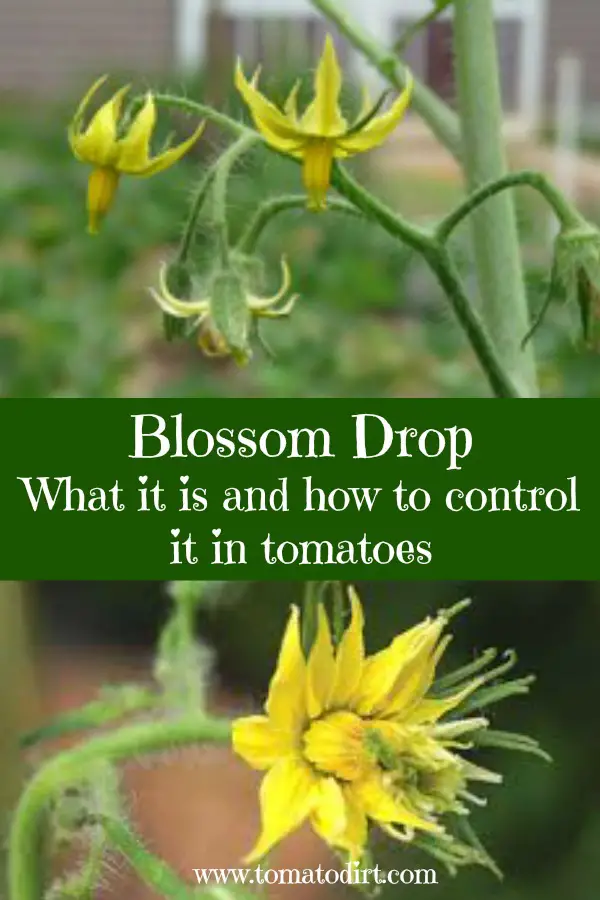Blossom Drop: Why Fruit Doesn’t Set and What To Do About It
Since 2010, Tomato Dirt has garnered 4.8+ million views, making it the web’s leading online source for growing tomatoes in the home garden. Award-winning writer and Tomato Dirt owner Kathy Widenhouse has helped thousands of home gardeners grow healthier tomatoes. Be one of them when you get Tomato Dirt’s Growing Guide here.
Updated 6.22.25
Blossom drop is a common tomato problem that is caused by stress or less-than-optimal growing conditions.
What is blossom drop?
Normally, a tomato blossom is pollinated and then fruit develops. This is called “setting fruit.”
But sometimes, a healthy tomato plant flowers, its blossoms drop, and no fruit develops. This is called “blossom drop.” It's a result of plant stress or poor pollination.
When does blossom drop affect tomato plants?
There are at least five conditions that can lead to blossom drop.
1. Extreme temperatures. Cool nights (consistently below 55ºF) or hot spells (days consistently about 90ºF and nights consistently above 75ºF) force the tomato plant to abandon fruit production and focus merely on surviving. Tomatoes’ optimum daytime temperature range for setting fruit is between 70º-85ºF.
2. Poor pollination. When temperatures are too hot or too cold, insects aren’t active in the garden. Not as many blossoms are pollinated. Along the same lines, without proper humidity (40-70%), pollen has difficulty releasing or sticking.
3. Stress. Tomatoes have deep root systems. Shallow watering develops shallow root systems, which can weaken tomato plants.
4. Improper fertilizing. Tomatoes are heavy feeders. Nitrogen (represented proportionally by the first number in a fertilizer’s three-number series) encourages leaf growth. Too much nitrogen-rich fertilizer, without accompanying phosphorus and potassium, can mean plants develop more leaves than fruit.
5. Too many blossoms. When a healthy tomato plant has many blossoms, they compete for food. Some won’t survive.
How do you control blossom drop?
While you cannot change temperature or humidity, there are a few steps you can take to help some tomato flowers to set fruit.
1. Combat extreme temperatures. Don’t plant tomatoes too early in the season. Also, choose types of tomatoes that are most appropriate for your climate. In cooler areas, plant early varieties which are more tolerant of cold nights. In southern regions, plant heat-tolerant varieties, which are more accustomed to setting fruit when the thermometer stretches upward.
2. Combat pollination problems. When blossoms emerge, mimic the work of wind and insects by gently shaking plants to spread pollen. You can also help pollination by planting flowers that attract insects among tomatoes. In dry areas, help pollen stick by misting tomato plants.
3. Combat water stress. Make sure tomato plants get 1-3 inches of water a week (including rain). Avoid watering daily, but rather water a couple of times a week deeply to allow root systems to grow strong.
4. Combat improper fertilization. Feed tomato plants with a balanced fertilizer or tomato fertilizer every 3-4 weeks. Avoid excess nitrogen (in proportion to other nutrients).
5. Combat too many blossoms. Some gardeners go to the extreme of pinching off blossoms on plants with excess flowers. But when there are plenty of blossoms, usually the “survival of the fittest” rule prevails. Count your blossom blessings and let fruit develop as it will.
6. Combat naturally with an extra boost. Many gardeners have had increased numbers of fruit set by using a natural plant hormone such as tomato blossom set spray.
Tomato problems from diseases
Different kinds of tomato blight and how to tell them apart ...
How to identify and treat Septoria leaf spot ...
6 Kinds of Tomato Plant Leaf Curl
and How to Treat Them
Tomato pests
Tomato hornworm: how to identify and control it ...
Tomato worms-cutworms: keep them away with stem collars ...
Stink bugs: how to identify and control them on tomato plants...
Tomato problems from growing conditions
Help Your Tomatoes Set Fruit with These Tips ...
15 ways to prevent blossom end rot in tomatoes ...
Sunscald: why too much sun can be hazardous to tomatoes...
Why a tomato cracks and what to do about it ...
Are bumps on tomato stems harmful to plants?
Blossom end rot: how to identify, treat, and prevent it ...
Tomato Catfacing: How to Identify and Prevent It ...
How to identify tomato problems and prevent them ...
More tips for managing tomato problems on our Pinterest board ...
Return from Blossom Drop-When Tomatoes Don't Set Fruit to Tomato Dirt home
As an Amazon Associate and Rakuten Advertising affiliate I earn from qualifying purchases.
SHARE THIS PAGE:
FREE! 10 Must-Know Tomato Growing Tips: 20-page guide
Get yours here:





New! Comments
Have your say about what you just read! Leave a comment in the box below.